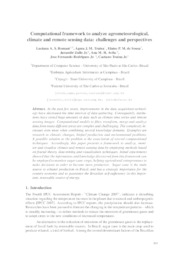Computational framework to analyze agrometeorological, climate and remote sensing data: challenges and perspectives.
Computational framework to analyze agrometeorological, climate and remote sensing data: challenges and perspectives.
Summary: In the past few years, improvements in the data acquisition technology have decreased the time interval of data gathering. Consequently, institutions have stored huge amounts of data such as climate time series and remote sensing images. Computational models to filter, transform, merge and analyze data from many different areas are complex and challenging. The complexity increases even more when combining several knowledge domains. Examples are research in climatic changes, biofuel production and environmental problems. A possible solution to the problem is the association of several computational techniques. Accordingly, this paper presents a framework to analyze, monitor and visualize climate and remote sensing data by employing methods based on fractal theory, data mining and visualization techniques. Initial experiments showed that the information and knowledge discovered from this framework can be employed to monitor sugar cane crops, helping agricultural entrepreneurs to make decisions in order to become more productive. Sugar cane is the main source to ethanol production in Brazil, and has a strategic importance for the country economy and to guarantee the Brazilian self-sufficiency in this important, renewable source of energy.
Publication year: 2009
Types of publication: Paper in annals and proceedings
Observation
Some of Embrapa's publications are published as ePub files. To read them, use or download one of the following free software options to your computer or mobile device. Android: Google Play Books; IOS: iBooks; Windows and Linux: Calibre.
Access other publications
Access the Agricultural Research Database (BDPA) to consult Embrapa's full library collection and records.
Visit Embrapa Bookstore to purchase books and other publications sold by Embrapa.

